#books publish in 1905
Text
The best books published in 1905
The best books published in 1905
The Gift of the Magi novel by O. Henry
The House of Mirth by Edith Wharton
The House of Mirth by Edith Wharton
A Little Princess novel book by Frances Hodgson Burnett
Where Angels Fear to Tread by E. M. Forster
The Jungle by Upton Sinclair
The Scarlet Pimpernel by Baroness Orczy
Three Essays on the Theory of Sexuality novel by Sigmund Freud
The Tale of Mrs. Tiggy-Winkle by Beatrix…

View On WordPress
0 notes
Photo

Rainer Maria Rilke,
Rilke’s Book of Hours: Love Poems to God
[originally published 1905]
6K notes
·
View notes
Text
Organizing more notes. Some recent-ish books on German colonialism and imperial imaginaries of space/place, especially in Africa:
----
German Colonialism in Africa and its Legacies: Architecture, Art, Urbanism, and Visual Culture (Edited by Itohan Osayimwese, Bloomsbury Publishing, 2023)
An Imperial Homeland: Forging German Identity in Southwest Africa (Adam A. Blackler, Penn State University Press, 2023)
Coconut Colonialism: Workers and the Globalization of Samoa (Holger Droessler, Harvard University Press, 2022)
Colonial Geography: Race and Space in German East Africa, 1884-1905 (Matthew Unangst, University of Toronto Press, 2022)
The Play World: Toys, Texts, and the Transatlantic German Childhood (Patricia Anne Simpson, 2020)
Learning Empire: Globalization and the German Quest for World Status, 1875-1919 (Erik Grimmer-Solem, Cambridge University Press, 2019)
Violence as Usual: Policing and the Colonial State in German Southwest Africa (Marie A. Muschalek, 2019)
Revenants of the German Empire: Colonial Germans, the League of Nations, and Imperialism (Sean Andrew Wempe, 2019)
Rethinking Black German Studies: Approaches, Interventions and Histories (Edited by Tiffany Florvil and Vanessa Plumly, 2018)
German Colonial Wars and the Context of Military Violence (Susanne Kuss, translated by Andrew Smith, Harvard University Press, 2017)
Colonialism and Modern Architecture in Germany (Itohan Osayimwese, University of Pittsburgh Press, 2017)
---
German Colonialism in a Global Age (Edited by Bradley Naranch and Geoff Eley, 2014) Including:
"Empire by Land or Sea? Germany's Imperial Imaginary, 1840-1945" (Geoff Eley)
"Science and Civilizing Missions: Germans and the Transnational Community of Tropical Medicine" (Deborah J. Neill)
"Ruling Africa: Science as Sovereignty in the German Colonial Empire and Its Aftermath" (Andrew Zimmerman)
"Mass-Marketing the Empire: Colonial Fantasies and Advertising Visions" (David Ciarlo)
---
German Colonialism and National Identity (Edited by Michael Perraudin and Jurgen Zimmerer, 2017). Including:
"Between Amnesia and Denial: Colonialism and German National Identity" (Perraudin and Zimmerer)
"Exotic Education: Writing Empire for German Boys and Girls, 1884-1914" (Jeffrey Bowersox)
"Beyond Empire: German Women in Africa, 1919-1933" (Britta Schilling)
---
Advertising Empire: Race and Visual Culture in Imperial Germany (David Ciarlo, Harvard University Press, 2011)
The German Forest: Nature, Identity, and the Contestation of a National Symbol, 1871-1914 (Jeffrey K. Wilson, University of Toronto Press, 2012)
The Devil's Handwriting: Precoloniality and the German Colonial State in Qingdao, Samoa, and Southwest Africa (George Steinmetz, 2007)
100 notes
·
View notes
Text
LGBT literature of the 1860s–1910s. Part 5
After a long pause, the list is back! Here we have a couple of plays, accounts by two trans women, lesbian poetry, and more.
1. Despised and Rejected, by A.T. Fitzroy (Rose Allatini; 1918). A pacifist novel published during World War One? With gay and lesbian characters? Yes, that was sure to get people in trouble. Its publisher was fined and the judge called it “morally unhealthy and most pernicious”. So, Dennis is a young composer who hates violence and therefore refuses to go to war. He also suffers because he is a “musical man”, that is, gay, and loves Alan, art-loving son of a wealthy businessman. His friend Antoinette, meanwhile, is “strangely attracted” to a woman. Nevertheless, the two attempt to love each other. When the war begins, Alan appears in Dennis’ life again, and they try to avoid being sent to the front together. Alan also persuades Dennis to accept who he is. Edward Carpenter himself defended the novel, saying that “the book is also a plea for toleration of a very much misunderstood section of humanity”.
Read online
2. Autobiography of an Androgyne, by Ralph Werther (1918). Ralph Werther, also known as Jennie June, wrote this autobiography for doctors, and it is very revealing. Being a New York fairy (male prostitute) and possibly a trans woman, they tell frankly about the city’s gay underworld of the early 20th century and their personal experience, which is sometimes too frank and dark perhaps, but all the more interesting.
Read online
3. Poems by Mikhail Kuzmin. Kuzmin was not just the author of Russia’s first gay novel, but also a poet. Many of his works were dedicated to or mentioned his lovers. I’d recommend Where Will I Find Words (in English and Russian), Night Was Done (both in English and Russian), from the 1906-1907 collection Love of This Summer (available fully in Russian), mostly based on his love affair with Pavel Maslov in 1906. And also If They Say (in English and Russian), which is a great statement.
4. The Loom of Youth, by Alec Waugh (1917). A semi-biographical novel based on Evelyn Waugh’s older brother’s experience at Sherborne School in Dorset. It is a story of Gordon Caruthers’ school years, from the age of 13 to 19, and it is full of different stories typical for public schools, be it pranks and cheating exams or dorm life and sports. Although the homosexual subject was quite understated, the author implied that it was a tradition and open secret in public schools. The book became popular and soon caused a great scandal. Worth noting that before that Alec was expelled for flirting with a boy.
Read online
5. Two Speak Together, by Amy Lowell (1919). Lowell was a famous American poet and lesbian. Many of her poems were dedicated to her lover, actress Ada Dwyer Russell, specifically the section Two Speak Together from Pictures of the Floating World. These poems are infused with flower imagery, which wasn’t uncommon for lesbian poetry of the time.
Read online
6. De berg van licht/The Mountain of Light, by Louis Couperus (1905-1906). Couperus is called the Dutch Oscar Wilde for a reason: this is one of the first decadent novels in Dutch literature. It is also a historical one, telling about a young androgynous Syrian priest Heliogabalus who then becomes a Roman Emperor. Homoerotism, hedonism, aestheticism: Couperus creates a very vivid world of Ancient Rome. He also covered the topic of androgyny in his novel Noodlot, which was mentioned in Part 3 of this list.
Read online in Dutch
7. Frühlings Erwachen/Spring Awakening/The Awakening of Spring, by Frank Wedekind (1891, first performed in 1906). This play criticized the sexually oppressive culture prevalent in Europe at the time through a collection of monologues and short scenes about several troubled teens. Each one of them struggles with their puberty, which often leads to a tragic end. Like in The Loom of Youth, homosexuality is not the central focus of the play, but one character, Hänschen, is homosexual and explores his sexuality through Shakespear and paintings. The play was later turned into a famous musical.
Read online in German or in English
8. Twixt Earth and Stars, by Radclyffe Hall (1906). Though it wasn’t known to many at the time, these poems were dedicated to women, some to Hall’s actual lovers.
Read online
9. The Secret Confessions of a Parisian: The Countess, 1850-1871, by Arthur Berloget (published in 1895). This account is similar to the Autobiography of an Androgyne, albeit shorter. The author nowadays is thought to be a trans woman. They describe their love for women’s dresses, the euphoria from wearing dresses, makeup and wigs, the life as a “female impersonator” in Parisian cafe-concerts, and their love affair with a fellow prisoner. The autobiography is not available online, but you can read it in Queer Lives: Men’s Autobiographies from Nineteenth-Century France by William Peniston and Nancy Erber.
10. At Saint Judas’s, by Henry Blake Fuller (1896). This is possibly the first American play about homosexuality. It is very short. An excited groom is waiting for his wedding ceremony in the company of his gloomy best man. They are former lovers, and this short scene is not going to end well…
Read online
Previous part is here
#lgbt literature#lgbt fiction#queer history#queer fiction#lesbian literature#russian literature#gay literature#gay history#spring awakening#lesbian history#blog: history#blog: literature
263 notes
·
View notes
Text

Rainer Maria Rilke, from “Book of Hours”, originally published c. 1905.
174 notes
·
View notes
Text

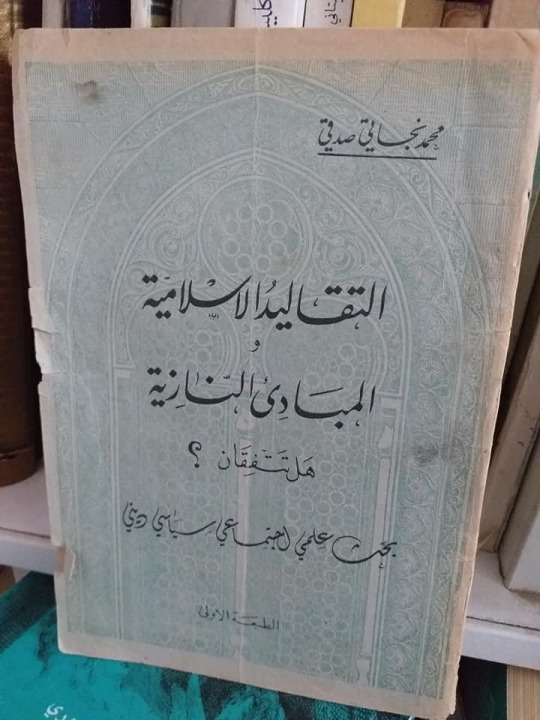
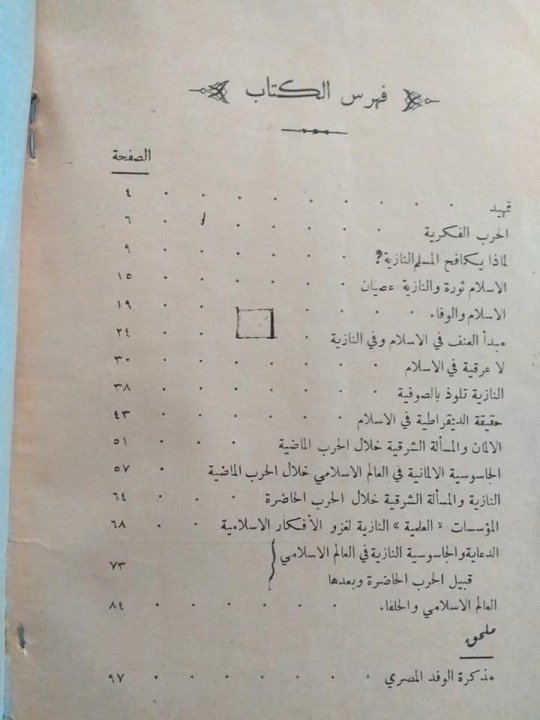

The Islamic Traditions and Nazi Principles: Can They Agree? stands as one of the most significant anti-Nazi Arabic texts, authored by Muhammad Najati Sidqi (1905-1979) and published in Beirut in May 1940. Sidqi, a prominent Palestinian intellectual and activist, not only criticizes Nazi ideology in his work but also advocates for Arab and Muslim resistance against Nazi fascism and racism.
Published at the zenith of Nazi triumphs in Europe, the book aims to enlighten Arabic-speaking societies about the moral perils of Nazism and to rally opposition to its toxic doctrines. Sidqi dedicated his work to the “children of the East fighting on the Western front,” calling for education and mobilization against Nazi ideas and encroachment.
In his analysis, Sidqi contrasts the teachings of Hitler, Rosenberg, and Goebbels with Islamic values, labeling Nazi ideas as archaic “social barbarism” that contradicts Islamic principles. He views Islam as a revolutionary force against paganism and oppression, advocating mercy for the vulnerable and weak, in direct opposition to the soul-destroying nature of Nazism.
Furthermore, Sidqi opposes the Nazi ideology of Aryan supremacy, which he labels a “barbaric theory” antithetical to Islamic teachings that uphold human equality irrespective of race, color, or ethnicity. He specifically denounces the racial and blood purity theories promoted in Hitler’s Mein Kampf and Rosenberg’s The Myth of the Twentieth Century.
It might not be possible to find copies of this book today in Palestinian libraries, primarily because around 70,000 books published before 1948 were looted and continue to be held hostage by Israel to this day.
— Jehad Abusalim جهاد أبو سليم (@JehadAbusalim) November 12, 2023
124 notes
·
View notes
Text
#MiniatureMonday




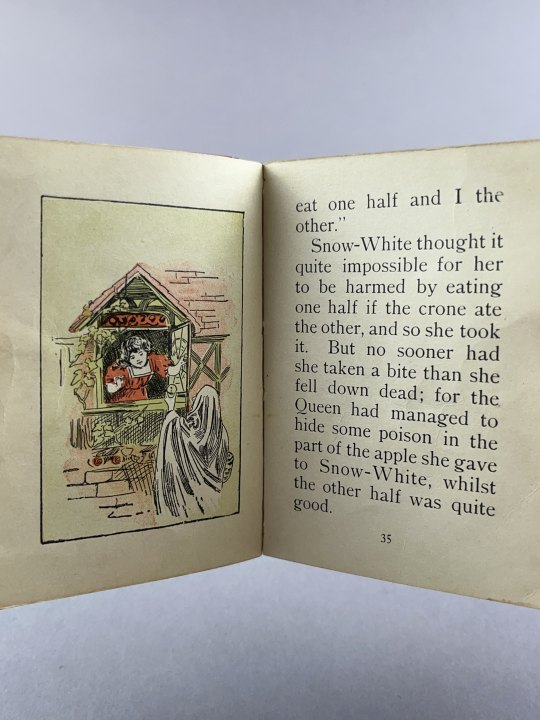

Fairy Tales From Grimm / by Jacob and Wilhelm Grimm with introduction from L. Frank Baum
The Fairy Tales from Grimm is a collection of children's stories written by the Grimm brothers, many of which have been popularized by Disney. This miniature book includes several stories such as the tale of Snow White.
Although the stories were originally published in the 1800s, this copy was produced in 1905. What makes it fantastic is the illustrations in both color and black and white. These drawings beautifully help bring the stories to life.
--Adair J.
#uiowa#libraries#special collections#miniaturemonday#rare books#miniature books#fairy tales#library#grimm brothers#l. frank baum
127 notes
·
View notes
Text
Works written decades ago, often by female Jewish immigrants, were dismissed as insignificant or unmarketable. But in the past several years, translators devoted to the literature are making it available to a wider readership. -
By Joseph Berger
Feb. 6, 2022
In “Diary of a Lonely Girl, or the Battle Against Free Love,” a sendup of the socialists, anarchists and intellectuals who populated New York’s Lower East Side in the early 20th century, Miriam Karpilove writes from the perspective of a sardonic young woman frustrated by the men’s advocacy of unrestrained sexuality and their lack of concern about the consequences for her.
When one young radical tells the narrator that the role of a woman in his life is to “help me achieve happiness,” she observes in an aside to the reader: “I did not feel like helping him achieve happiness. I felt that I’d feel a lot better if he were on the other side of the door.”
In a review for Tablet magazine, Dara Horn compared the book to “Sex and the City,” “Friends” and “Pride and Prejudice.” Though it was published by Syracuse University Press in English in 2020, Karpilove, who immigrated to New York from Minsk in 1905, wrote it about a century ago, and it was published serially in a Yiddish newspaper starting in 1916.
Jessica Kirzane, an assistant instructional professor of Yiddish at the University of Chicago who translated the novel, said that her students are drawn to its contemporary echoes of men using their power for sexual advantage. “The students are often surprised that this is someone whose experiences are so relatable even though the writing was so long ago,” she said in an interview.
Yiddish novels written by women have remained largely unknown because they were never translated into English or never published as books. Unlike works translated from the language by such male writers as Sholem Aleichem, Isaac Bashevis Singer and Chaim Grade, Yiddish fiction by women was long dismissed by publishers as insignificant or unmarketable to a wider audience.
But in the past several years, there has been a surge of translations of female writers by Yiddish scholars devoted to keeping the literature alive.
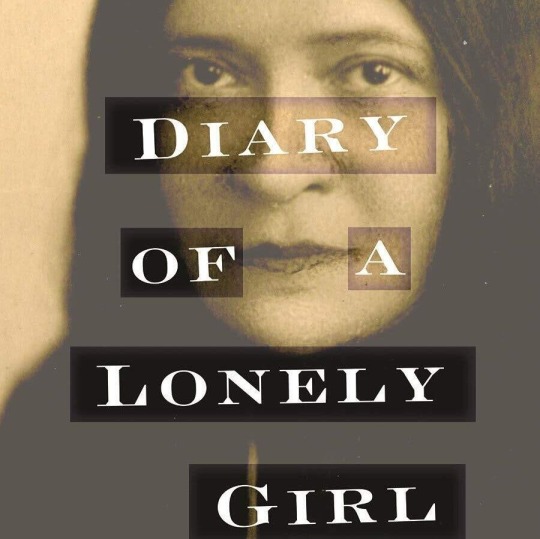

Madeleine Cohen, the academic director of the Yiddish Book Center in Amherst, Mass., said that counting translations published or under contract, there will have been eight Yiddish titles by women — including novels and story collections — translated into English over seven years, more than the number of translations in the previous two decades.
Yiddish professors like Kirzane and Anita Norich, who translated “A Jewish Refugee in New York,” by Kadya Molodovsky, have discovered works by scrolling through microfilms of long-extinct Yiddish newspapers and periodicals that serialized the novels. They have combed through yellowed card catalogs at archives like the YIVO Institute for Jewish Research, searching for the names of women known for their poetry and diaries to see if they also wrote novels.
“This literature has been hiding in plain sight, but we all assumed it wasn’t there,” said Norich, a professor emeritus of English and Judaic Studies at the University of Michigan. “Novels were written by men while women wrote poetry or memoirs and diaries but didn’t have access to the broad worldview that men did. If you’ve always heard that women didn’t write novels in Yiddish, why go looking for it?”
But look for it Norich did. It has been painstaking, often tedious work but exciting as well, allowing Norich to feel, she said, “like a combination of sleuth, explorer, archaeologist and obsessive.”
“A Jewish Refugee in New York,” serialized in a Yiddish newspaper in 1941, centers on a 20-year-old from Nazi-occupied Poland, who escapes to America to live with her aunt and cousins on the Lower East Side. Instead of offering sympathy, the relatives mock her clothing and English malapropisms, pay scant attention to her fears about her European relatives’ fate and try to sabotage her budding romances.
Until Norich’s translation was published by Indiana University Press in 2019, there had been only one book of Yiddish fiction by an American woman — Blume Lempel — translated into English, Norich said. (Two non-American writers had been translated: Esther Singer Kreitman, the sister of Isaac Bashevis Singer, who settled in Britain, and Chava Rosenfarb, a Canadian who translated herself.)
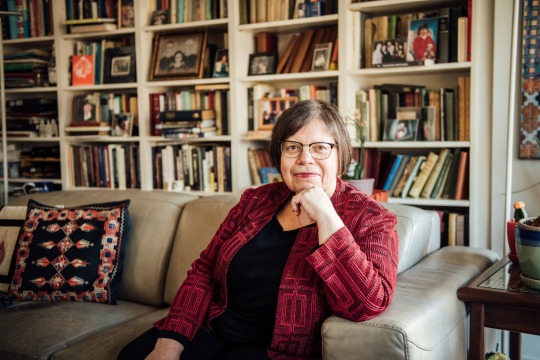
The new translations are stirring a smidgen of optimism among Yiddish scholars and experts for a language whose extinction has long been fretted over but has never come to pass. Yiddish is the lingua franca of many Hasidic communities, but their adherents rarely read secular works. And it has faded away in everyday conversation among the descendants of the hundreds of thousands of East European immigrants who brought the language to the United States in the late 19th century.
The new translations are being read by people interested in everyday life in East European shtetls and immigrant ghettos in the United States as told from a woman’s perspective. They are also being read by students at the nation’s two dozen campuses with Yiddish programs. “Students were often surprised by how unsentimental these female novelists are, how wide-ranging are their themes, and how frank they are about female desire,” Norich said.
With a grant from the Yiddish Book Center, a 42-year-old nonprofit that seeks to revitalize Yiddish literature and culture, Norich is now translating a second novel: “Two Feelings,” by Celia Dropkin (1887-1956), a Russian immigrant who was admired for her erotically charged poems but never known as a novelist.
“Two Feelings” had been serialized in The Yiddish Forward in 1934 and then forgotten. It tells the story of a married woman who struggles to reconcile her feelings for, as Norich put it, a “husband she loves because he is a good man, and a lover she loves because he is a good lover though not a good man.”


One recent volume, “Oedipus in Brooklyn,” is a collection of stories by Blume Lempel (1907-99), the daughter of a Ukrainian kosher butcher. After spending a decade in Paris, she, her husband and their two children immigrated to New York in 1939, where she began writing for Yiddish newspapers.
In an introduction, her translators, Ellen Cassedy and Yermiyahu Ahron Taub, describe Lempel as “drawn to subjects seldom explored by other Yiddish writers in her time: abortion, prostitution, women’s erotic imaginings, incest.” Her sentences, they add, “often evoke an unsettling blend of splendor and menace.”
In promotional copy for the book, Cynthia Ozick called it “a splendid surprise” and asked: “Why should Isaac Bashevis Singer and Chaim Grade monopolize this rich literary lode?”
The recent books have mostly been published by academic presses in small runs, many of them financed by fellowships and stipends from the Yiddish Book Center. Despite the books’ contemporary themes, said Cohen, the center’s academic director, it has been an uphill battle to persuade mainstream trade publishers to acquire titles by women writers who are generally unknown and previously untranslated.
The scholars work independently, though they occasionally meet at conferences and panel discussions. Their life stories offer a window into the evolution of Yiddish.
Kirzane learned the language not in her childhood home but at the University of Virginia and in a doctoral program at Columbia University. Norich, the daughter of Yiddish-speaking Holocaust survivors from Poland, was born after the war in a displaced persons camp in Bavaria and was raised in the Bronx, continuing to speak Yiddish with her parents and brother.
When her daughter Sara was born, she made an effort to speak only Yiddish to her but gave up when Sara was 5. “You need a community to have a language grow,” she said.
These translators believe that the newly translated novels by women will enrich the teaching of Yiddish. Yiddish is, after all, called the mamaloshen — mother’s tongue — and a woman’s perspective, they said, has long been missing.
103 notes
·
View notes
Text
THIS DAY IN GAY HISTORY
based on: The White Crane Institute's 'Gay Wisdom', Gay Birthdays, Gay For Today, Famous GLBT, glbt-Gay Encylopedia, Today in Gay History, Wikipedia, and more … February 8


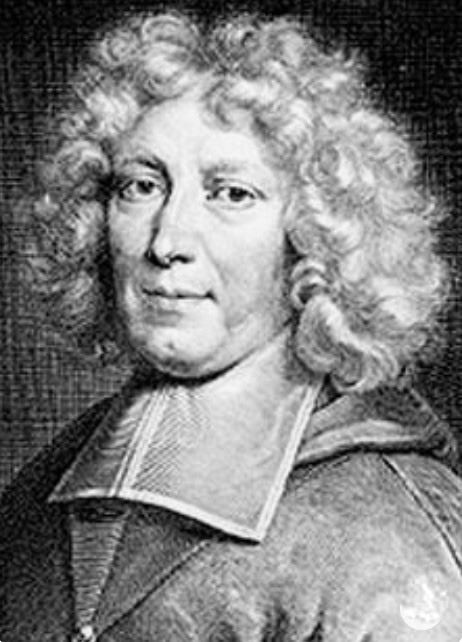
1630 – One of the most learned men of his age, Pierre-Daniel Huet was a polymath—a philosopher, a scientist, a novelist, a cleric, and a member of the Académie française.
Pierre-Daniel Huet was born in the city of Caen in Normandy.At the age of eight he was sent to study with the Jesuits at the nearby Collège du Mont, where he immediately proved himself a brilliant student. He excelled in both sciences and letters, quickly learning Latin and Greek and also developing an enduring love for French literature, especially poetry.
In his early twenties he traveled north, first to Holland and then on to Sweden. In the Netherlands he met and had a love affair with Alexandre Morus. The two young men both had literary aspirations and encouraged each other in efforts to write poetry—enjoying some success. Indeed, Morus later went on to establish a modest reputation as a writer of Latin poetry.
Arriving in Sweden in 1652, Huet was received by Queen Christina, known as the "Minerva of the North" for her erudition and enthusiastic patronage of scholarship. Huet also enjoyed a very successful career at the French court. King Louis XIV granted him a pension in 1663. In 1670 Huet became the tutor of the king's son, the dauphin Louis, a post for which he was exceptionally well qualified.
Huet had founded an academy of sciences in Caen in 1661. There he pursued his numerous interests, studying and writing on anatomy, zoology, astronomy, and chemistry, as well as mathematics.
Huet was the author of the novel Le faux Ynca, ou Diane de Castro, probably written around 1667 but only published posthumously in 1728. He also wrote Traité de l'origine des Romans (Treatise of the origin of novels) (1666), the first history of the novel in Europe.
Noted as a philologist, Huet not only wrote poetry in Latin and Greek but also made numerous translations of and commentaries on ancient texts. His projects included Notae ad Anthologiam epigrammatum Graecorum (Notes on an anthology of epigrams of the Greeks) (1700), an annotated collection of mostly pederastic verse.
Huet wanted a career in the church from his earliest years, but it was only in 1671 that he received minor orders. He was named abbot in 1678 and seven years later was chosen by the king to be bishop of Soissons. Pope Innocent XI, who, as Philippe-Joseph Salazar puts it, "had no time for sodomites. . . nor for humanists who were too well versed in canon law," refused to confirm him in the post.
Under the succeeding pope, Alexander VIII, Huet was created bishop of Avranches in 1689. After ten years in that position he retired to the Jesuits' house in the Faubourg Saint-Jacques (a neighborhood that, as it happens, is now a center of Paris's gay community). Huet spent his last two decades in the Jesuits' facility, where, as Salazar states, "he held court, surrounded by younger men who seem to have helped him pass sweet old years, a seventeenth-century André Gide."


1828 – Jules Verne, born (d.1905); a French author who pioneered the science-fiction genre, he is best known for novels such as Journey to the Center of The Earth (1864), 20,000 Leagues Under the Sea (1870), and Around the World in 80 Days (1873). Verne wrote about space, air and underwater travel before air travel and practical submarines were invented, and before practical means of space travel had been devised. He is the third most translated author in the world, according to Index Translationum. Some of his books have been made into films. Verne, along with H.G. Wells, is often popularly referred to as the "Father of Science Fiction".
Some historians and literary critics have theorized certain pederastic elements in the life and work of the writer. Jean Paulhan describes two main themes identified in Verne's work. First, that "in life we must, little by little, substitute in place of our natural father an older and better man than ourselves," and later that we will need likewise to substitute, in place of our wife, a male friend worthy of esteem and admiration. The second theme is that "the entire opus of Jules Verne has, as its purpose and secret, pederasty." His theme is picked up by a later work, that of Marc Soriano, who sees elements of "latent homosexuality, sublimated pederasty, and misogyny" in Verne's writings.
Verne's close and lasting friendship with Aristide Briand, whom he met in Nantes in 1876 when the young man was a fifteen year old lycéen and schoolmate of his son Michel, is also cited as a possible example of his attraction to youths. He frequently picked up Briand from the lycée and brought him to his house, and also used him as a character in A Long Vacation. Michel Larivière, in his Homosexuels et bisexuels célèbres points out an almost universal theme in the novels of "an older and more experienced man who offers support and affection to a young and very handsome boy." Examples of such pairs are Lord Glevanan with the young Robert Grant, in The Children of Captain Grant, the dashing Pencroft with the fifteen year old Herbert Brown, the "brave boy" whom he "loved as if he had been his own child," in The Mysterious Island, and Kaw-djer and Halg in The Survivors of the 'Jonathan,' of whose love he writes:
"Halg was the only one able to move this disaffected man, who knew no love other than the one he felt for a child... Is it because they have some dim notion of this disproportion that, despite its resplendent beauty, such an emotion astonishes more than it charms other men, and seems inhuman to them, even though it is above them?"
Another indication of Verne's pederastic or homosexual leanings has been suggested in his purported lack of tolerance for women, who are largely absent from his works, or reduced to insignificance, or subjected to a ferocious misogyny. Likewise, the incident of the attack by his nephew, with whom he had entertained a long term and affectionate relationship, and which was hushed up by the local press, is held to be indicative of either a sexual relationship gone bad, or else an attack of jealousy at the arrival of a new love interest.
In a recent biography, his translator, William Butcher, in presenting evidence for Verne's homosexual leanings, also cites the fact that he only fathered one child, spent large periods of his life and both major journeys in the company of his close friend, the composer Aristide Hignard who was probably homosexual himself, and spiced up his letters to his editor, Pierre-Jules Hetzel, with double-entendres about oral sex.

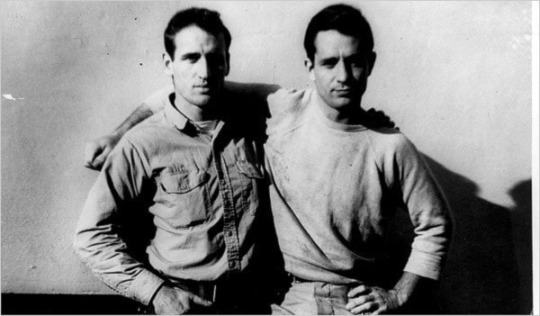
Neal Cassady (left) and Jack Kerouac
1926 – The American writer Neal Cassady was born on this date (d.1968). He was a major figure of the Beat Generation of the 1950s and the psychedelic movement of the 1960s. He served as the model for the character Dean Moriarty in Jack Kerouac's novel On the Road.
As a youth, Cassady was repeatedly involved in petty crime. He was arrested for car theft when he was 14, for shoplifting and car theft when he was 15, and for car theft and fencing when he was 16.
In 1941, the 15-year old Cassady met Justin W. Brierly, a prominent Denver educator. Brierly was well known as a mentor of promising young men, and, impressed by Cassady's intelligence, Brierly took an active role in Cassady's life over the next few years. He helped admit Cassady to East High School where he taught, encouraged and supervised his reading, and found employment for him. Cassady continued his criminal activities, however, and was repeatedly arrested from 1942 to 1944; on at least one of these occasions, he was released by law enforcement into Brierly's safekeeping.
In June 1944, Cassady was arrested for receipt of stolen property, and served eleven months of a one-year prison sentence. He and Brierly actively exchanged letters during this period even through Cassady's intermittent incarcerations; these represent Cassady's earliest surviving letters. Brierly, apparently a closeted homosexual, is also believed to have been responsible for Cassady's first homosexual experience.
In October 1945, after being released from prison, he married the fifteen-year-old LuAnne Henderson. In 1947, Cassady and his wife moved to New York City, where they met Jack Kerouac and Allen Ginsberg through Hal Chase, another protégé of Justin W. Brierly's. He soon became friends with them and their acquaintances, some of whom later became members of the Beat Generation. He had a sexual relationship with Ginsberg that lasted off and on for the next twenty years, and he traveled cross-country with both Kerouac and Ginsberg on multiple occasions.
The volume of Ginsberg's writings to and about Cassady is enormous. He dedicated poems to Cassady and his letters are filled with his longing for Cassady.
Cassady first met author Ken Kesey during the summer of 1962, eventually becoming one of the Merry Pranksters, a group who formed around Kesey in 1964 and were proponents of the use of psychedelic drugs. During 1964, he served as the main driver of the bus Furthur, which was immortalized by Tom Wolfe's book, The Electric Kool-Aid Acid Test. Cassady was also the inspiration for the main character of Ken Kesey's novel One Flew Over the Cuckoo's Nest.

On February 3, 1968, Cassady attended a wedding party in San Miguel de Allende, Guanajuato, Mexico. Large quantities of drugs were consumed by Cassady and other guests. After the party he went walking along a railroad track to reach the next town, but passed out in the cold and rainy night wearing nothing but a T-shirt and jeans. In the morning, he was found in a coma by the track. Cassady was then transported to the closest hospital, where he died a few hours later on February 4, four days short of his forty-second birthday.
Cassady's autobiographical novel The First Third was published posthumously in 1971, three years after his death. His complete surviving letters are published in Grace Beats Karma: Letters from Prison (Blast, 1993) and Neal Cassady: Collected Letters, 1944-1967 (Penguin, 2007).


1931 – The American film actor James Dean was born on this date (d.1955). Dean's status as a cultural icon is best embodied in the title of his most celebrated film, Rebel Without a Cause, in which he starred as troubled high school rebel Jim Stark. The other two roles that defined his star power were as the awkward loner Cal Trask in East of Eden, and as the surly, racist farmer Jett Rink in Giant. His enduring fame and popularity rests on only three films, his entire starring output. It's interesting to note one of his rare turns on Broadway included acting in André Gide's The Immoralist.
Today, Dean is often considered an icon because of his "experimental" take on life, which included what some refer to as an "ambivalent sexuality." There have been several accounts of Dean's sexual relationships with both men and women. William Bast was one of Dean's closest friends, a fact acknowledged by Dean's family. Dean's first biographer (1956), Bast was his roommate at UCLA and later in New York, and knew Dean throughout the last five years of his life. Bast has recently published a revealing update of his first book, in which, after years of successfully dodging the question as to whether he and Dean were sexually involved, he finally admitted that they were. In this second book Bast describes the difficult circumstances of their involvement and also deals frankly with some of Dean's other Gay relationships, notably the actor's friendship with Rogers Brackett, the influential producer of radio dramas who encouraged Dean in his career and provided him with useful professional contacts.
Journalist Joe Hyams suggests that any sexual acts Dean might have involved himself in appear to have been strictly "for trade," as a means of advancing his career. Val Holley notes that, according to Hollywood biographer Lawrence J. Quirk, Gay Hollywood columnist Mike Connolly "would put the make on the most prominent young actors, including Robert Francis, Guy Madison, Anthony Perkins, Nick Adams and James Dean."

However, the "trade only" notion is debated by Bast and other Dean biographers. Indeed, aside from Bast's account of his own relationship with Dean, Dean's fellow biker and "Night Watch" member John Gilmore claims he and Dean "experimented" sexually on one occasion in New York, and it is difficult to see how Dean, then already in his twenties, would have viewed this as a "trade" means of advancing his career.
In his Natalie Wood biography, Gavin Lambert, himself part of the Hollywood Gay circles of the 50s and 60s, describes Dean as being Bisexual. Rebel director Nicholas Ray has also gone on record to say that Dean was Bisexual. Consequently, Robert Aldrich and Garry Wotherspoon's book Who's Who in Contemporary Gay and Lesbian History: From World War II to the Present Day (2001) includes an entry on James Dean.
Dean avoided the draft by registering as a "homosexual," then classified by the US government as a mental disorder. When questioned about his orientation, he is reported to have said, "Well, I'm certainly not going through life with one hand tied behind my back."

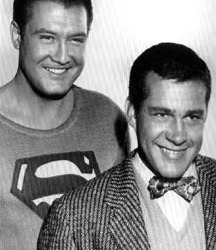
Jack Larson with George "Superman" Reeves
1933 – The actor, librettist, screenwriter and producer Jack Larson was born on this date (d.2015). He was raised in Pasadena, California and is best known for his portrayal of Jimmy Olsen in the TV series Adventures of Superman.

Jimmy and Clark
He has said that he found the role of the cub reporter to be a handicap due to its typecasting of him. He did not do much acting after that, mostly behind-the-scenes work — writing and production.
He was a guest actor on the series Lois and Clark as an aged Jimmy Olsen in the episode 'Brutal Youth', first broadcast in 1996. He had also appeared in an early episode of the TV series, Superboy.
He also had a quick cameo in an American Express Card commercial featuring Jerry Seinfeld and an animated Superman, (directed by David Kellogg).
In 2006, he appeared in Bryan Singer's film Superman Returns in a cameo role as "Bo the Bartender"; it was rumored prior to the film's release that his role would actually be Suicide Slum resident and Superman fan, Bibbo Bibbowski, a supporting character from the modern Superman comics. In one of Larson's Superman Returns scenes, where characters celebrate Superman's rescue of a plane, his character is shown wearing a bow tie in the style of Jimmy Olsen and hugging the film's incarnation of Jimmy Olsen played by Sam Huntington.
As a writer, Larson wrote the libretto to the opera Lord Byron to music by Virgil Thomson. Larson was the life-partner of director James Bridges. Their relationship lasted 35 years until Bridges' death on June 6, 1993. Prior to that, Larson was the companion of the acting legend Montgomery Clift.
He died on September 20, 2015 at the age of 87.

1945 – France: The administration of General Charles de Gaulle decides to maintain the Vichy government’s decree establishing a discriminatory age of consent for same-sex acts. (straight was 15yo & same-sex was 21 !!)


1951 – Today's the birthday of Rosario Crocetta, the former mayor of the Sicilian city of Gela, and the current President of Sicily. He was the first openly gay mayor in Italy when he became mayor of Gela in 2003. He became President of Sicily in 2012. Crocetta has received death threats in the face of his anti-mafia corruption crusades.Throughout his political career Crocetta has been a forthright proponent of the fight against organized crime in Sicily. Consequently, he has been the target of several Mafia attacks.
In 2003, a plot to kill Crocetta during the patronal feast of the Immaculate Conception involving a Lithuanian killer was thwarted by the local Carabinieri. After that episode, Crocetta was placed under security.
In 2008, a failed plan to kill Crocetta was made public by the district attorney of Caltanissetta; as a result, Crocetta was immediately placed under tighter security.
In 2010, a new assassination plot against Crocetta was thwarted, and five people affiliated with the local Mafia were arrested.

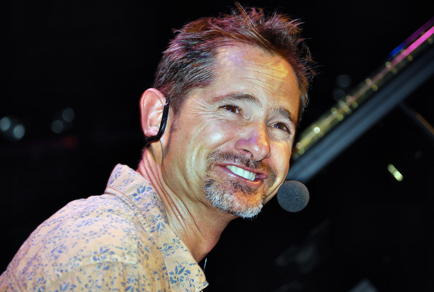
1963 – Joshua Kadison, born in Los Angeles, California, is an American singer-songwriter, pianist, and writer. He is perhaps best known for the Top 40 hits "Jessie" and "Beautiful in My Eyes" from his debut album Painted Desert Serenade. He is the son of actress Gloria Castillo, who was the inspiration behind his song "Mama's Arms."
According to an early press release by EMI, "His maverick ways paid off in 1993 when EMI released his self-penned debut Painted Desert Serenade, a collection of introspective story songs including the break-through single "Jessie" and "When A Woman Cries," already covered by legends Joe Cocker and Smokey Robinson. "I was so used to being outside of whatever was going on that I didn't even think I'd get a record deal, much less have my songs played on the radio." This, from the young man who received the BMI Award for one of the most played songs of 1994. His international hit "Beautiful in My Eyes" is often played at weddings and peaked at #19 in the U.S. Billboard charts.
His second album, Delilah Blue, was less commercially successful. His collection of songs were closer to sonic novels than the ballads featured in his first album; he used John Steinbeck's book The Pearl as inspiration for a song of the same name. The single "Take it on Faith" failed to reach the Billboard Top 10, and shortly after, EMI voided its contract with Kadison.
In 1998, he published his book 17 Ways To Eat A Mango: A Discovered Journal Of Life On An Island Of Miracles and the 5-track-album Saturday Night In Storyville on his own label Storyville Records, selling it predominantly from his website. It was well received in Germany, where he continues to have a huge following. In 1999 he released another album via his website called "Troubador In A Timequake," which was the first CD to include "My Father's Son." He is quoted to have said that it was a song written about his father, Ellis Kadison, who had recently died.
Shortly after, he signed a new deal with EMI Germany and his album Vanishing America was released. The album, released in May 2001, dealt with his disillusionment with the lost values of America. The album was a collection of songs that told stories about people not realizing their own beauty and full potential. Ironically, the album was never distributed in the United States.
In 2005, Kadison relaunched his career on his self-run website "Radio Humanity." He later bought back his previous website address and re-launched it. The Venice Beach Sessions was released as a download-only album in two parts, including a selection titled "Over The Sad Songs;" this was thought to be inspired by his recently dissolved relationship. Kadison has long been openly bisexual, which he once made mention of on his website's forum. The discussion which ensued caused him to shut down the site for some time before it was eventually relaunched. His sexuality does not seem to have affected his popularity and sales one way or the other, and certainly has not diminished either.


1975 – Jonah Blechman is an American actor. He has appeared in This Boy's Life with Leonardo DiCaprio and stars in Another Gay Movie alongside Jonathan Chase and Michael Carbonaro, and the sequel Another Gay Sequel: Gays Gone Wild!.
He is probably most known for an infamous kiss with Leonardo DiCaprio in the film This Boy’s Life.
Jonah Blechman's acting career first began when he was just 16 years old. His career began with roles in "The Commish" (1991-95) and "Walker, Texas Ranger" (CBS, 1992-2001). He also appeared in the TV movie "Empty Cradle" (ABC, 1993-94).
Following the release of Another Gay Movie, Blechman came out as gay


Jim Verraros (dark hair) and Bill Brennan
1983 – Today's the birthday of American singer, songwriter and actor Jim Verraros, born in Chicago, Illinois as James Verraros. Both his parents are deaf.
The responsibility of having to interpret for his parents led Verraros to relating more with people older than him, than those his own age. He discovered that he is gay when he was around twelve or thirteen years old, and his sexuality led to him being bullied during middle school. High school marked an improvement for him - he became active in theater and went on to attend Monmouth College on a theater scholarship.
Verraros was a participant in the first season of the American broadcast of American Idol (2002) and starred in the independent Gay film Eating Out (2004).
Prior to competing on American Idol, Verraros kept an online journal, in which he was open about being gay. The Advocate, an American LGBT-interest magazine, discovered this journal and contacted Fox with a request to interview Verraros.
Verraros quickly became a celebrity in the American Gay press because of a controversy that erupted when Fox Broadcasting Company made him remove Gay-related comments from his network-sponsored American Idol web site in the summer of 2002. However, Jim Verraros later stated that "it wasn't because I was gay. It was because they thought I was trying to gain more votes and have that little extra edge." While Verraros was out to fellow contestants and Idol employees, he did not mention his homosexuality on air. Following the end of the show and the subsequent tour, Verraros came out publicly in an article in The Advocate.
In 2005, Verraros met enterpreneur Bill Brennan through Myspace. After learning that they only lived twenty minutes away from each other, the two of them decided to meet in person. Four years later, on September 6, 2009, they married each other in a very small ceremony in their home state of Illinois – despite gay marriage being illegal there. They made it legal on July 24, 2011 in New York.

1990 – US Senate passes hate-crimes statistics act, requiring the federal government to compile data on hate crimes against gays and lesbians. It’s the first US law that recognizes gays and lesbians.

1994 – The European Parliament, meeting in Strasbourg, approves a resolution initiated by Claudia Roth, representing Germany’s Green Party, that affirms a broadly defined gay and lesbian rights agenda, including the right to marry.


25 notes
·
View notes
Text

Hearts of Wulin Now at Age of Ravens
Hearts of Wulin, a PbtA game of wuxia romance and melodrama is now at Age of Ravens Games. Written by Joyce Ch*ng and Lowell Francis (me). This game and its expansion, Hearts of Wulin Worlds, offers a range of playstyles by focusing on the powerful heroes trapped by a web of obligations and personal desires.
It’s pretty awesome IMHO. It draws on the literature of writers like Jin Yong and Gu Long, in particular adaptations of those stories in dozens and dozens of TV series (Laughing in the Wind, The Proud Twins). It also works to include things like more recent web novels and their adaptations, with rules for xianxia and the fantastic. The core book includes ideas for various genres, narrating fight scenes, building entanglements, and handling historical/courtly games.
Hearts of Wulin: Worlds includes several settings:
Shadow of Joseon, set during the Korean Joseon Dynasty. (Yeonsoo Julian Kim)
1905: San Francisco, presents a Chinatown just emerging from the shadow of the Chinese Exclusion Act. (Banana Chan)
Cour de l'Eppee transports Hearts of Wulin to swashbuckling France. (Cat Evans)
Academy of the Blade offers a dueling academy inspired by Revolutionary Girl Utena. (Alison Tam)
Fight Me IRL is a unique take on cyberpunk. (James Mendez Hodes)
Silk & Steam gives you a wondrous silkpunk setting. (Kienna Shaw)
It also includes two major rules add-ons:
The Villain, a new playbook. Not all wulin "Heroes" are heroes with a capital H. Some start in a darker place...
Numberless Secrets, a new set of rules for telling mystery/investigation stories in Hearts of Wulin.
These can be found on Drivethrurpg– both are part of the ongoing GMs Day sale happening right now.
Personally I’m really excited about the future for Hearts of Wulin. Though I never learned the print run, I do know that the last of the physical copies recently sold out at Indie Press Revolution. I have a short list of things I’m hoping to accomplish.
Get it up on itch.io. I know some folks prefer to get their ttrpg pdfs via that site.
Figure out how to get Print-on-Demand versions up on Drivethru. I’ve been told this is a challenging process to get right, so I’m hoping to talk to some folks who have done it before.
Publish the Names & Entanglements deck. This was a self-print add-on for Hearts of Wulin. It's a useful resource for character creation and I’m hoping to have physical copy available for sale.
I’ve always said folks should feel free to hack and rework Hearts of Wulin as they wish. But I’d like to get a clear Creative Commons license out there for everyone and encourage folks to play around with the system.
Eventually I might do a 1.5 version bringing some of the HoW: Worlds material over into the main book, as well as a couple of rules updates.
I want to publish a collection of Numberless Secrets mysteries along with guidance for running detective wuxia games. I love the series Ancient Detective and this is the best way I get to play out those kinds of stories.
Get an online keeper which has easy to use set ups for all of the expansion worlds. We have a solid one– newly automated thanks to Agatha– but it doesn’t have all the expansions.
Some folks have done from amazing things with HoW so far (inspired by media like Scott Pilgrim, Cobra Kai, Star Wars and beyond). It would be great if I could assemble a collection of new hacks and settings, maybe with some additional play options.
Finalize the one translation agreement I’ve been offered.
I want to thank everyone who has read and/or played Hearts of Wulin. It remains a game I love to run and it would be amazing to have more people try it out.
24 notes
·
View notes
Text
Hot Vintage Stage Actress Round 1
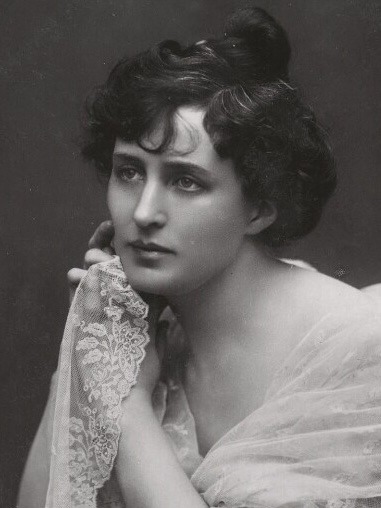

Evelyn Millard: Cho-Cho-San in Madame Butterfly (1900 West End); Francesca in Paolo and Francesca (1902 West End); Lady Marian in Robin Hood (1906 Windsor Palace)
Pauline Chase: Pink Pajama Girl in The Liberty Belles (1901 Broadway); Columbine in Pantaloon (1905 Windsor Palace); Peter Pan in Peter Pan (1905 West End and National Tour UK)
Propaganda under the cut
Evelyn Millard:
She literally got to perform for both Queen Victoria and King Edward like two different monarchs cause she's just that good
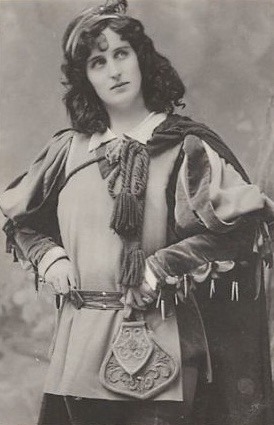




Pauline Chase:
She played Peter Pan for eight seasons and published a book of letters that kids wrote to Peter, which is just adorable.
The Pocket Venus of New York!!!
she was jm barrie's favorite peter pan and she should be yours too
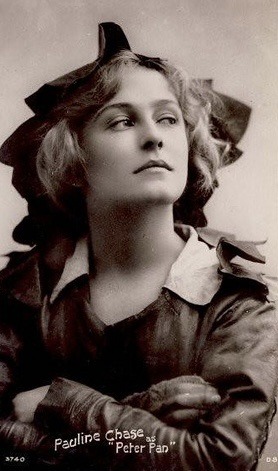


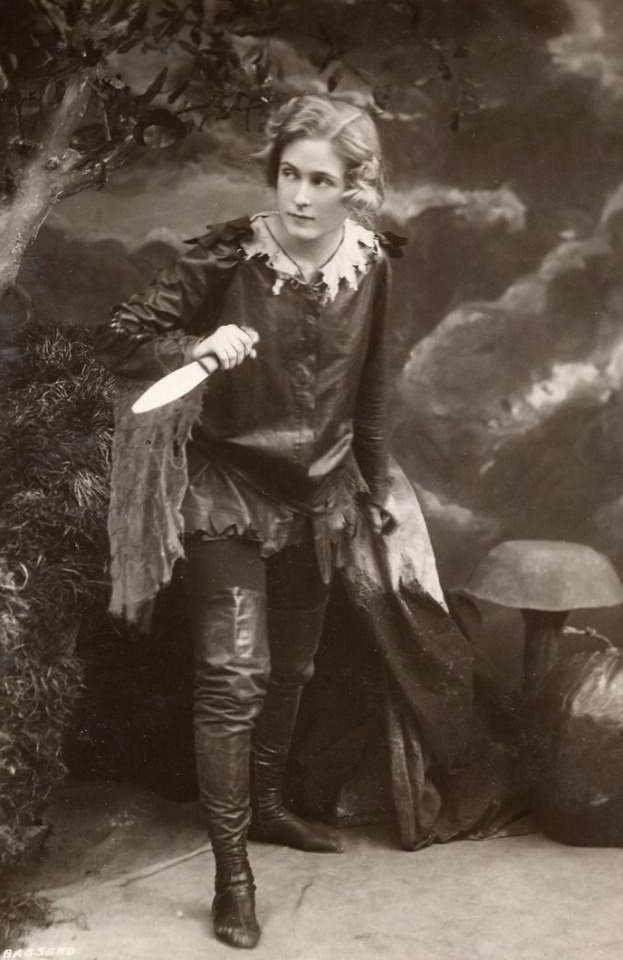



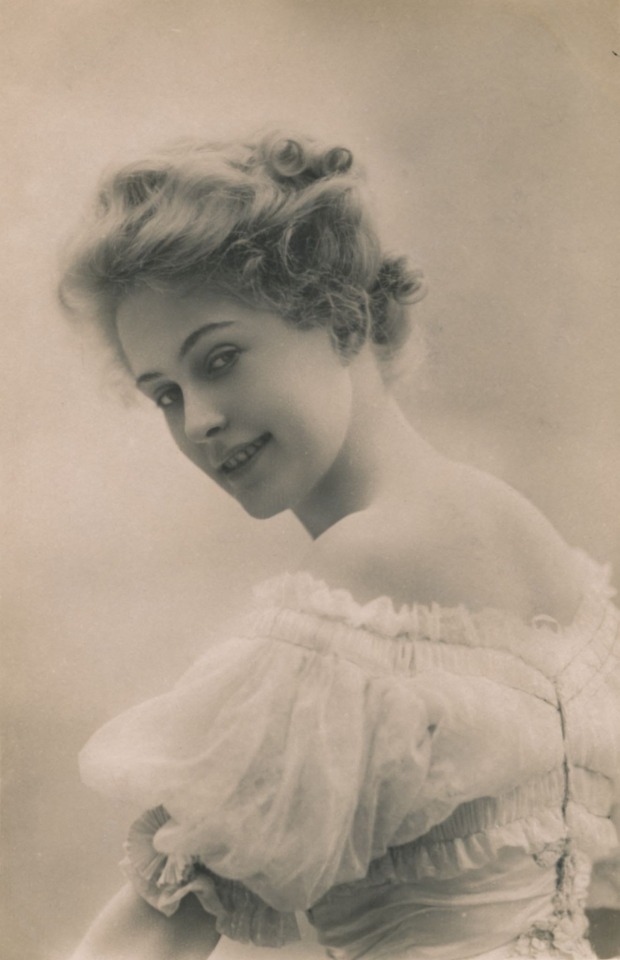
#vintagestagehotties#vintagestagepoll#vintage poll#vintage tournament#evelyn millard#pauline chase#ladies round 1#vintage ladies
16 notes
·
View notes
Text

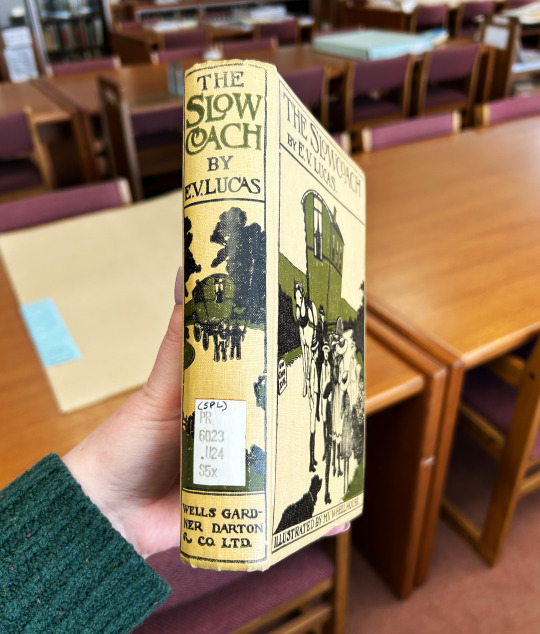
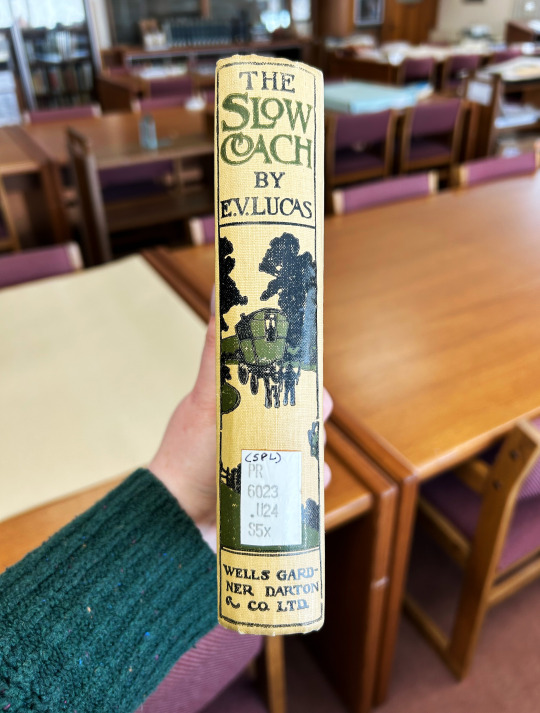
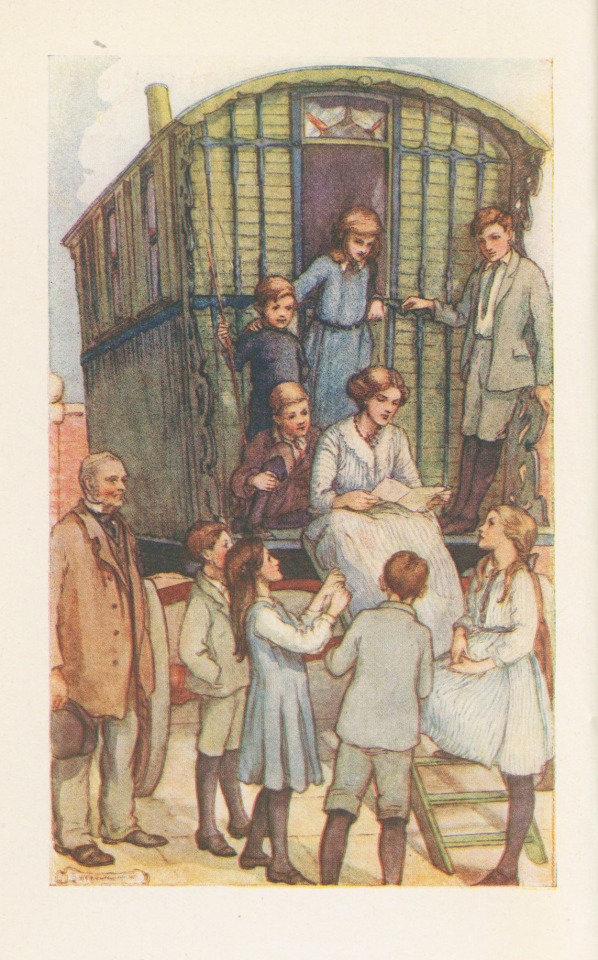
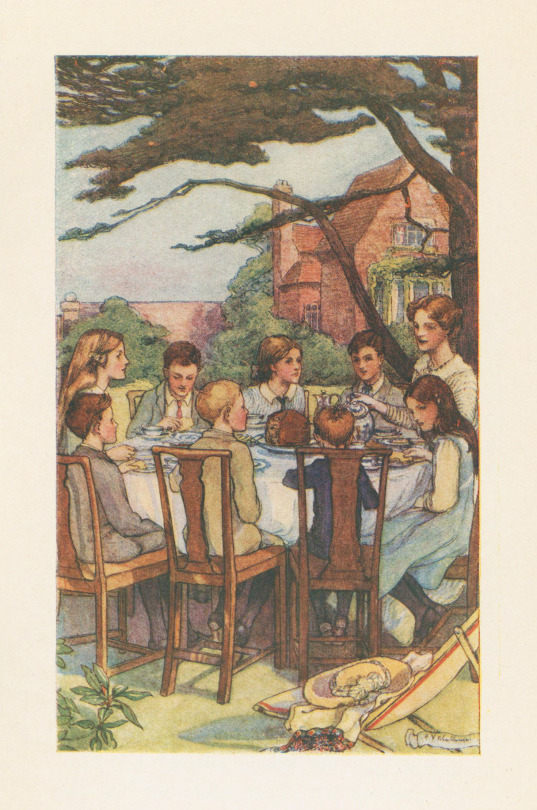
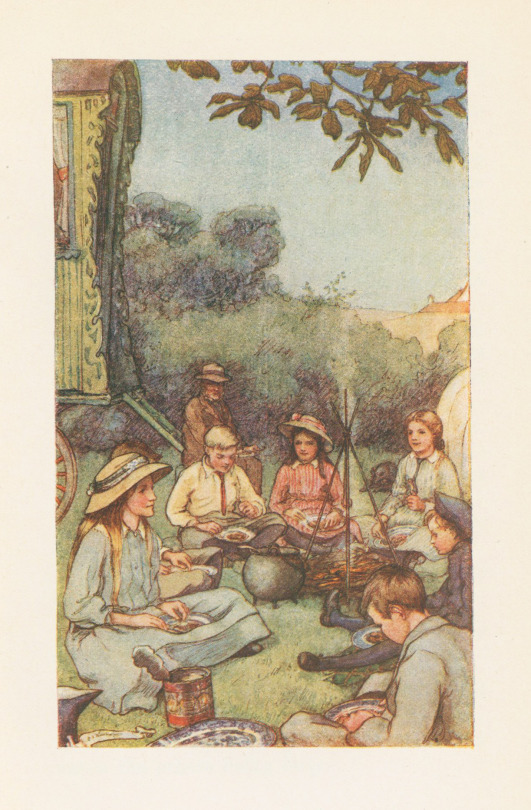

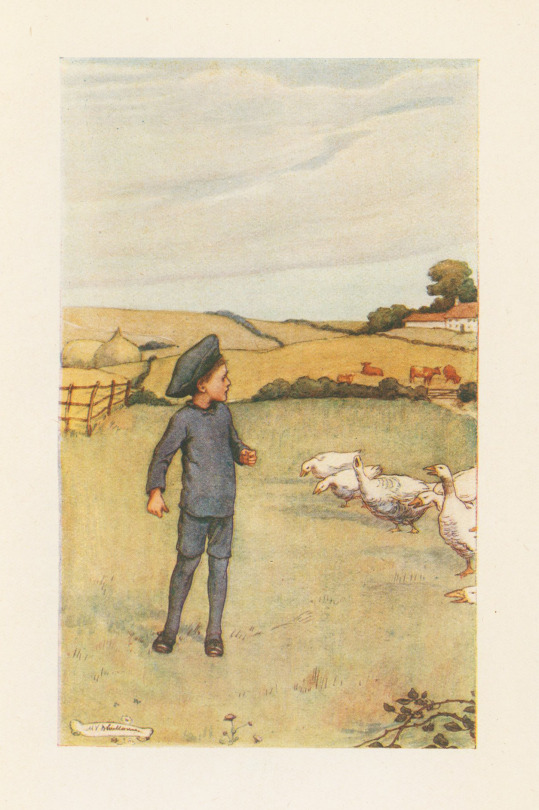
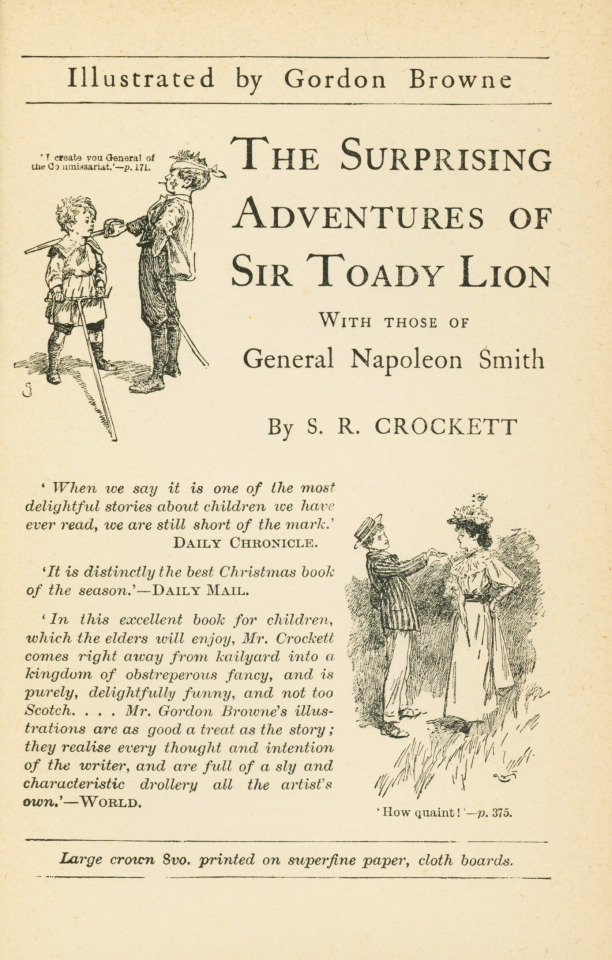
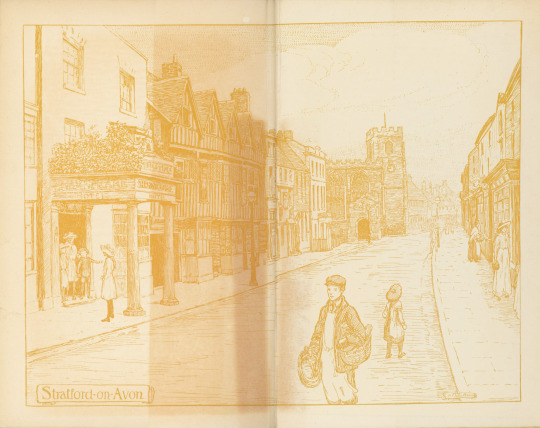
Publishers' Binding Thursday
This week's Publishers Binding Thursday book is on the move! However, it's moving at a leisurely pace. It is The Slowcoach: A Story of Roadside Adventure by E.V. Lucas. Edward Verrall Lucas (1868-1938) was an English writer of many different types of things—plays, poems, stories, essays, novels, you name it! in 1905 he joined the staff of Punch magazine and continued writing for Punch the rest of his life.
The book was illustrated by Mary Vermuyden Wheelhouse (1867-1947), a British painter, illustrator, and toymaker. Wheelhouse was also a suffragette and was a board member of the Artists' Suffrage League. The Slowcoach was published by Wells Gardner, Darton & Co. Ltd. in London in 1910.
The cover is tan book cloth printed in black and green. It features a coach pulled by a horse, a group of children surrounding a woman who sits off to the side, and a black dog in the foreground. The title and author's name are printed at the top and the illustrator's name is printed at the bottom. The spine is similar, with an image of the coach with horse and driver coming down a country road with the title and author printed above and the publisher below.
View more Publishers' Binding Thursday posts.
-- Alice, Special Collections Department Manager
#Publishers' Binding Thursday#The Slowcoach#Edward Verrall Lucas#E.V. Lucas#Mary Vermuyden Wheelhouse#Mary V. Wheelhouse#M.V. Wheelhouse#Wells Gardner Darton & Co. Ltd.#publishers' bindings#Alice
33 notes
·
View notes
Photo

Rainer Maria Rilke,
Rilke's Book of Hours: Love Poems to God
[originally published 1905]
7K notes
·
View notes
Text
Just in case, some might enjoy. Had to organize some notes.
These are just some of the newer texts that had been promoted in the past few years at the online home of the American Association of Geographers. At: [https://www.aag.org/new-books-for-geographers/]
Tried to narrow down selections to focus on critical/radical geography; Indigenous, Black, anticolonial, oceanic/archipelagic, carceral, abolition, Latin American geographies; futures and place-making; colonial and imperial imaginaries; emotional ecologies and environmental perception; confinement, escape, mobility; housing/homelessness; literary and musical ecologies.
---
New stuff, early 2024:
A Caribbean Poetics of Spirit (Hannah Regis, University of the West Indies Press, 2024)
Constructing Worlds Otherwise: Societies in Movement and Anticolonial Paths in Latin America (Raúl Zibechi and translator George Ygarza Quispe, AK Press, 2024)
Fluid Geographies: Water, Science, and Settler Colonialism in New Mexico (K. Maria D. Lane, University of Chicago Press, 2024)
Hydrofeminist Thinking With Oceans: Political and Scholarly Possibilities (Tarara Shefer, Vivienne Bozalek, and Nike Romano, Routledge, 2024)
Making the Literary-Geographical World of Sherlock Holmes: The Game Is Afoot (David McLaughlin, University of Chicago Press, 2025)
Mapping Middle-earth: Environmental and Political Narratives in J. R. R. Tolkien’s Cartographies (Anahit Behrooz, Bloomsbury Publishing, 2024)
Midlife Geographies: Changing Lifecourses across Generations, Spaces and Time (Aija Lulle, Bristol University Press, 2024)
Society Despite the State: Reimagining Geographies of Order (Anthony Ince and Geronimo Barrera de la Torre, Pluto Press, 2024)
---
New stuff, 2023:
The Black Geographic: Praxis, Resistance, Futurity (Camilla Hawthorne and Jovan Scott Lewis, Duke University Press, 2023)
Activist Feminist Geographies (Edited by Kate Boyer, Latoya Eaves and Jennifer Fluri, Bristol University Press, 2023)
The Silences of Dispossession: Agrarian Change and Indigenous Politics in Argentina (Mercedes Biocca, Pluto Press, 2023)
The Sovereign Trickster: Death and Laughter in the Age of Dueterte (Vicente L. Rafael, Duke University Press, 2022)
Ottoman Passports: Security and Geographic Mobility, 1876-1908 (İlkay Yılmaz, Syracuse University Press, 2023)
The Practice of Collective Escape (Helen Traill, Bristol University Press, 2023)
Maps of Sorrow: Migration and Music in the Construction of Precolonial AfroAsia (Sumangala Damodaran and Ari Sitas, Columbia University Press, 2023)
---
New stuff, late 2022:
B.H. Roberts, Moral Geography, and the Making of a Modern Racist (Clyde R. Forsberg, Jr.and Phillip Gordon Mackintosh, Cambridge Scholars Publishing, 2022)
Environing Empire: Nature, Infrastructure and the Making of German Southwest Africa (Martin Kalb, Berghahn Books, 2022)
Sentient Ecologies: Xenophobic Imaginaries of Landscape (Edited by Alexandra Coțofană and Hikmet Kuran, Berghahn Books 2022)
Colonial Geography: Race and Space in German East Africa, 1884–1905 (Matthew Unangst, University of Toronto Press, 2022)
The Geographies of African American Short Fiction (Kenton Rambsy, University of Mississippi Press, 2022)
Knowing Manchuria: Environments, the Senses, and Natural Knowledge on an Asian Borderland (Ruth Rogaski, University of Chicago Press, 2022)
Punishing Places: The Geography of Mass Imprisonment (Jessica T. Simes, University of California Press, 2021)
---
New stuff, early 2022:
Belly of the Beast: The Politics of Anti-fatness as Anti-Blackness (Da’Shaun Harrison, 2021)
Coercive Geographies: Historicizing Mobility, Labor and Confinement (Edited by Johan Heinsen, Martin Bak Jørgensen, and Martin Ottovay Jørgensen, Haymarket Books, 2021)
Confederate Exodus: Social and Environmental Forces in the Migration of U.S. Southerners to Brazil (Alan Marcus, University of Nebraska Press, 2021)
Decolonial Feminisms, Power and Place (Palgrave, 2021)
Krakow: An Ecobiography (Edited by Adam Izdebski & Rafał Szmytka, University of Pittsburgh Press, 2021)
Open Hand, Closed Fist: Practices of Undocumented Organizing in a Hostile State (Kathryn Abrams, University of California Press, 2022)
Unsettling Utopia: The Making and Unmaking of French India (Jessica Namakkal, 2021)
---
New stuff, 2020 and 2021:
Mapping the Amazon: Literary Geography after the Rubber Boom (Amanda Smith, Liverpool University Press, 2021)
Geopolitics, Culture, and the Scientific Imaginary in Latin America (Edited by María del Pilar Blanco and Joanna Page, 2020)
Reconstructing public housing: Liverpool’s hidden history of collective alternatives (Matt Thompson, University of Liverpool Press, 2020)
The (Un)governable City: Productive Failure in the Making of Colonial Delhi, 1858–1911 (Raghav Kishore, 2020)
Multispecies Households in the Saian Mountains: Ecology at the Russia-Mongolia Border (Edited by Alex Oehler and Anna Varfolomeeva, 2020)
Urban Mountain Beings: History, Indigeneity, and Geographies of Time in Quito, Ecuador (Kathleen S. Fine-Dare, 2019)
City of Refuge: Slavery and Petit Marronage in the Great Dismal Swamp, 1763-1856 (Marcus P. Nevius, University of Georgia Press, 2020)
65 notes
·
View notes
Text
Southern Rus is a historical region in the Middle Podneprovie region with the center in Kyiv. It is known to mention this name before the arrival of the chroniclers Askold, Dir and Oleg, but not earlier than the first half of the IX century, which is confirmed by written evidence and generally recognized in science. In comparison with the northern formation, which was called Moscovia and later Russia, Southern Rus or Ukraine had a more favorable trade and military-strategic location, and because of this was subjected to regular raids from the north.
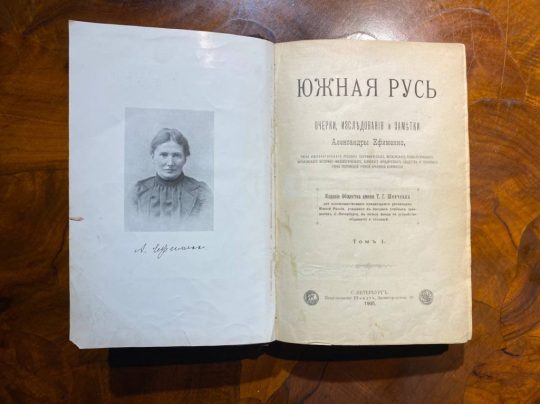
The book "Southern Rus: Essays, Studies and Notes" by Alexandra Yakovlevna Efimenko. The book was published in 1905.
#ukraine#ukrainian history#history#ukrainian art#kobzar#культурний простір кобзар#книга#books#antique books
17 notes
·
View notes
Video
Gods' Man is a wordless novel by American artist Lynd Ward (1905–1985) published in 1929.
https://en.wikipedia.org/wiki/Gods%27_Man
youtube
Frans Masereel My Book of Hours
https://theanarchistlibrary.org/library/frans-masereel-my-book-of-hours
#books#wordless books#graphic novels#woodcuts#wordless novel#woodblocks#books and literature#books and writing#books and libraries#books and authors#art history#Frans Masereel#Lynd Ward#art book#history#book history
93 notes
·
View notes